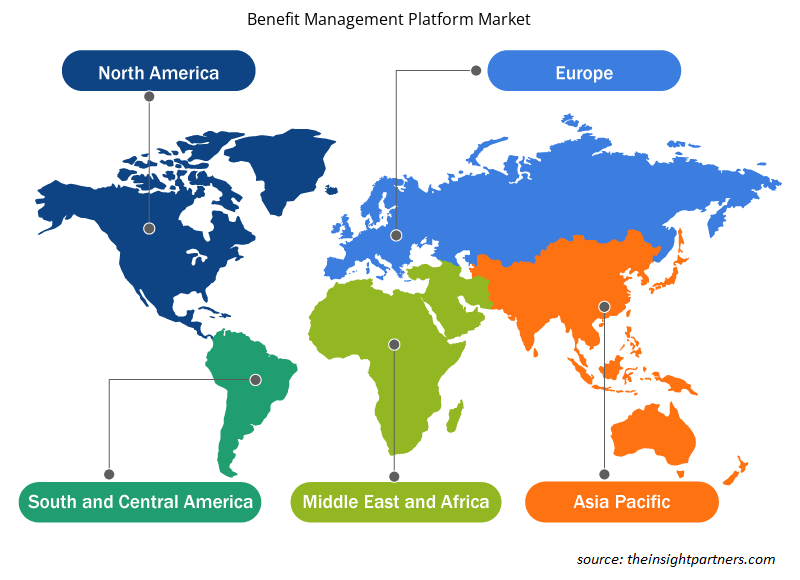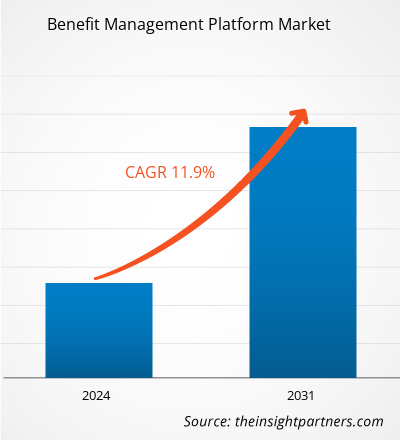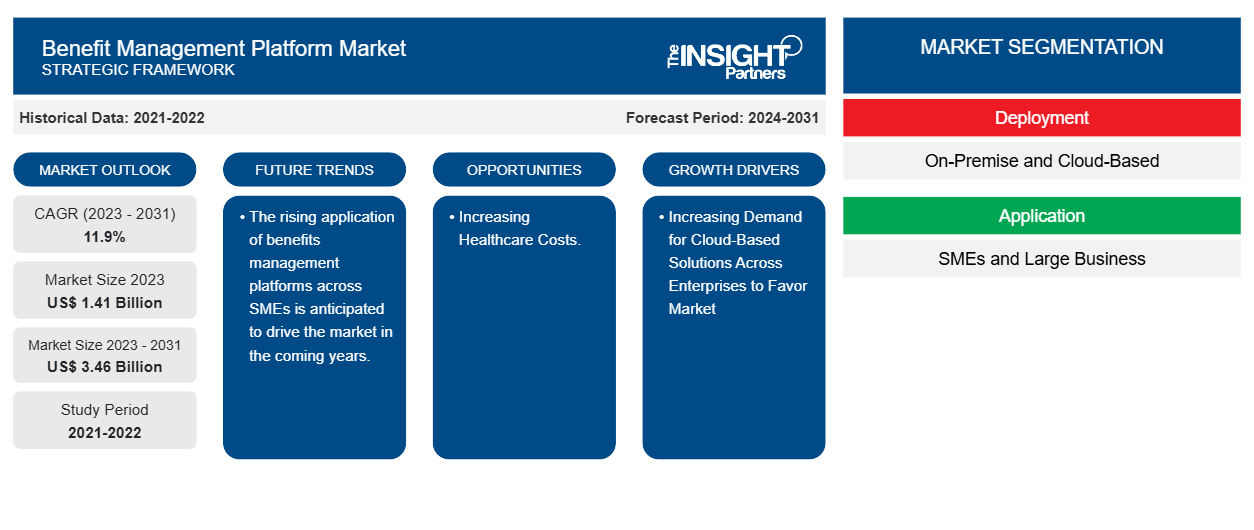Der Markt für Leistungsmanagementplattformen soll von 1,41 Milliarden US-Dollar im Jahr 2023 auf 3,46 Milliarden US-Dollar im Jahr 2031 anwachsen. Der Markt wird zwischen 2023 und 2031 voraussichtlich eine durchschnittliche jährliche Wachstumsrate (CAGR) von 11,9 % verzeichnen. Das zunehmende Wachstum cloudbasierter Lösungen in verschiedenen Unternehmen und höhere Gesundheitskosten werden voraussichtlich weiterhin wichtige Trends und Treiber des Marktes bleiben.
Marktanalyse für Benefit-Management-Plattformen
Die Nachfrage nach Plattformen für Leistungsmanagement wird voraussichtlich mit dem zunehmenden Wachstum von Cloud-basierten Lösungen in Unternehmen und der größeren Nachfrage nach durch Technologien unterstütztem Komfort wachsen; höhere Gesundheitskosten treiben das Marktwachstum an. Darüber hinaus wird erwartet, dass mehrere Regierungsinitiativen und zunehmende Anwendungen bei KMU das Marktwachstum im Prognosezeitraum ankurbeln werden.
Marktübersicht für Benefit-Management-Plattformen
Benefit-Management-Plattformen sind darauf ausgelegt, das Verhalten eines Mitarbeiters zu erkennen und dem Arbeitgeber zu helfen, verschiedene Vorteile für einen effizienten Geschäftsbetrieb anzubieten. Solche Lösungen sind sinnvoll, um die Arbeitsmoral der Mitarbeiter zu steigern und ihre Beschäftigung im Unternehmen zu belohnen. Diese Plattformen werden aufgrund ihrer technologischen Innovationen häufig in Unternehmen praktisch jeder Größe eingesetzt.
Passen Sie diesen Bericht Ihren Anforderungen an
Sie erhalten kostenlos individuelle Anpassungen an jedem Bericht, einschließlich Teilen dieses Berichts oder einer Analyse auf Länderebene, eines Excel-Datenpakets sowie tolle Angebote und Rabatte für Start-ups und Universitäten.
-
Holen Sie sich die wichtigsten Markttrends aus diesem Bericht.Dieses KOSTENLOSE Beispiel umfasst eine Datenanalyse von Markttrends bis hin zu Schätzungen und Prognosen.
Treiber und Chancen auf dem Markt für Leistungsmanagementplattformen
Steigende Nachfrage nach Cloud-basierten Lösungen in Unternehmen begünstigt den Markt
Die steigende Nachfrage nach Cloud-basierten Lösungen in Unternehmen treibt das Wachstum des Marktes für Benefit-Management-Plattformen voran. Cloud-basierte Lösungen lassen sich leicht skalieren, um dem Wachstum von Unternehmen gerecht zu werden, egal ob sie neue Mitarbeiter einstellen oder global expandieren. Benefit-Management-Plattformen können auch die Kosten von IT-Abonnementmodellen senken. Darüber hinaus verbessern sie den Fernzugriff auf Echtzeit-Updates. Darüber hinaus gibt es auf dem Markt mehrere Benefit-Management-Plattformen. Zenefits beispielsweise ist eine Cloud-basierte HR-Plattform, die eine breite Palette von Funktionen bietet, darunter Leistungsverwaltung, Lohn- und Gehaltsabrechnung, Zeiterfassung und Compliance-Management. Darüber hinaus bietet sie eine intuitive Benutzeroberfläche für Mitarbeiter zur Verwaltung ihrer Leistungen und lässt sich in verschiedene Anwendungen von Drittanbietern integrieren. Die steigende Nachfrage nach Cloud-basierten Lösungen in Unternehmen treibt also das Marktwachstum voran.
Steigende Gesundheitskosten.
In den letzten Jahren sind die steigenden Kosten der Gesundheitsversorgung zu einem dringenden Problem für Arbeitgeber und Arbeitnehmer geworden. Angesichts der stetig steigenden medizinischen Kosten wird die Nachhaltigkeit der Leistungen an Arbeitnehmer auf den Prüfstand gestellt. Da die Gesundheitsversorgung immer teurer wird, stehen Unternehmen vor der Herausforderung, solide Leistungspakete aufrechtzuerhalten, die Talente anziehen und halten und gleichzeitig die Kosten effektiv verwalten. Dies erhöht die Nachfrage nach Leistungsmanagementplattformen. Angesichts der steigenden Gesundheitskosten suchen Arbeitgeber und Einzelpersonen nach Möglichkeiten, die Kosten zu verwalten und zu senken. Daher bieten die steigenden Gesundheitskosten enorme Chancen für den Markt für Leistungsmanagementplattformen.
Segmentierungsanalyse des Marktberichts zur Leistungsmanagementplattform
Wichtige Segmente, die zur Ableitung der Marktanalyse für Leistungsmanagementplattformen beigetragen haben, sind Entwicklung und Anwendung.
- Basierend auf der Entwicklung ist der Markt für Leistungsmanagementplattformen in On-Premises- und Cloud-basierte Plattformen unterteilt. Das Cloud-basierte Segment wird im Prognosezeitraum voraussichtlich einen erheblichen Anteil haben.
- Basierend auf der Anwendung wird der Markt für Leistungsmanagementplattformen in KMU und Großunternehmen unterteilt. Das KMU-Segment wird im Prognosezeitraum voraussichtlich einen erheblichen Anteil haben.
Marktanteilsanalyse für Benefits-Management-Plattformen nach geografischer Lage
Der geografische Umfang des Marktberichts zur Leistungsmanagementplattform ist hauptsächlich in fünf Regionen unterteilt: Nordamerika, Asien-Pazifik, Europa, Naher Osten und Afrika sowie Süd- und Mittelamerika.
Nordamerika dominiert den Markt. Das Wachstum des nordamerikanischen Marktes ist auf die zunehmende Einführung von Cloud-basierten Lösungen und die steigende Nachfrage nach effizienter Verwaltung von Mitarbeiterleistungen zurückzuführen. Außerdem steigt die Nachfrage nach automatisierten Lösungen zur Analyse und Verwaltung von Mitarbeiterleistungen. Darüber hinaus tragen die technologischen Fortschritte in der Region und der ständige Fokus auf Forschung und Entwicklung zum Wachstum des Marktes bei. In der Region gibt es eine große Anzahl von Anbietern von Leistungsmanagementplattformen. All diese Faktoren treiben das Wachstum des Marktes für Leistungsmanagementplattformen voran, der in Nordamerika an Fahrt gewinnt.
Regionale Einblicke in den Markt für Leistungsmanagementplattformen
Die regionalen Trends und Faktoren, die den Markt für Leistungsmanagementplattformen im Prognosezeitraum beeinflussen, wurden von den Analysten von Insight Partners ausführlich erläutert. In diesem Abschnitt werden auch die Marktsegmente und die Geografie von Leistungsmanagementplattformen in Nordamerika, Europa, im asiatisch-pazifischen Raum, im Nahen Osten und Afrika sowie in Süd- und Mittelamerika erörtert.

- Erhalten Sie regionale Daten zum Markt für Leistungsmanagementplattformen
Umfang des Marktberichts zur Leistungsmanagementplattform
| Berichtsattribut | Details |
|---|---|
| Marktgröße im Jahr 2023 | 1,41 Milliarden US-Dollar |
| Marktgröße bis 2031 | 3,46 Milliarden US-Dollar |
| Globale CAGR (2023 - 2031) | 11,9 % |
| Historische Daten | 2021-2022 |
| Prognosezeitraum | 2024–2031 |
| Abgedeckte Segmente |
Nach Bereitstellung
|
| Abgedeckte Regionen und Länder |
Nordamerika
|
| Marktführer und wichtige Unternehmensprofile |
|
Dichte der Marktteilnehmer für Benefit-Management-Plattformen: Deren Auswirkungen auf die Geschäftsdynamik verstehen
Der Markt für Benefit-Management-Plattformen wächst rasant, angetrieben durch die steigende Nachfrage der Endnutzer aufgrund von Faktoren wie sich entwickelnden Verbraucherpräferenzen, technologischen Fortschritten und einem größeren Bewusstsein für die Vorteile des Produkts. Mit steigender Nachfrage erweitern Unternehmen ihr Angebot, entwickeln Innovationen, um die Bedürfnisse der Verbraucher zu erfüllen, und nutzen neue Trends, was das Marktwachstum weiter ankurbelt.
Die Marktteilnehmerdichte bezieht sich auf die Verteilung der Firmen oder Unternehmen, die in einem bestimmten Markt oder einer bestimmten Branche tätig sind. Sie gibt an, wie viele Wettbewerber (Marktteilnehmer) in einem bestimmten Marktraum im Verhältnis zu seiner Größe oder seinem gesamten Marktwert präsent sind.
Die wichtigsten auf dem Markt für Leistungsmanagementplattformen tätigen Unternehmen sind:
- Benefitfocus.Com Inc
- BSwift LLC
- Empyrean
- Mitarbeiter-Navigator
- Leichtigkeit
- ADP, Inc.
Haftungsausschluss : Die oben aufgeführten Unternehmen sind nicht in einer bestimmten Reihenfolge aufgeführt.

- Überblick über die wichtigsten Akteure auf dem Markt für Leistungsmanagementplattformen
Neuigkeiten und aktuelle Entwicklungen zum Markt für Leistungsmanagementplattformen
Der Markt für Leistungsmanagementplattformen wird durch die Erhebung qualitativer und quantitativer Daten nach Primär- und Sekundärforschung bewertet, die wichtige Unternehmenspublikationen , Verbandsdaten und Datenbanken umfasst. Nachfolgend sind einige der Entwicklungen auf dem Markt für Leistungsmanagementplattformen aufgeführt:
- Capgemini gab bekannt, dass es eine neue Vereinbarung mit Kallio Software zur Entwicklung eines einheitlichen Leistungsverwaltungssystems zur Unterstützung von fast einer Million Arbeitslosengeldempfängern in Finnland unterzeichnet hat. Diese neue Plattform soll die Bearbeitung von Leistungsantragsprozessen schneller und kundenorientierter machen und so das Kundenerlebnis verbessern. (Quelle: Capgemini, Unternehmenswebsite, Mai 2024)
- BambooHR hat Benefits Administration eingeführt, eine Lösung zur Vereinfachung des Anmeldevorgangs für Sozialleistungen. Benefits Administration integriert die Anmeldung von Sozialleistungen für Mitarbeiter in die BambooHR-Plattform und bietet allen Benutzern ein schnelleres und bequemeres Erlebnis.
(Quelle: BambooHR, Unternehmenswebsite, Juni 2023)
Marktbericht zu Benefit-Management-Plattformen: Umfang und Ergebnisse
Der Bericht „Marktgröße und Prognose für Benefit-Management-Plattformen (2021–2031)“ bietet eine detaillierte Analyse des Marktes, die die folgenden Bereiche abdeckt:
- Marktgröße und Prognose für Benefit-Management-Plattformen auf globaler, regionaler und Länderebene für alle abgedeckten wichtigen Marktsegmente.
- Markttrends für Leistungsmanagementplattformen sowie Marktdynamik wie treibende Faktoren, Einschränkungen und wichtige Chancen.
- Detaillierte PEST/Porters Five Forces- und SWOT-Analyse
- Analyse des Marktes für Leistungsmanagementplattformen, die wichtige Markttrends, globale und regionale Rahmenbedingungen, wichtige Akteure, Vorschriften und aktuelle Marktentwicklungen umfasst.
- Branchenlandschaft und Wettbewerbsanalyse, einschließlich Marktkonzentration, Heatmap-Analyse, prominenten Akteuren und aktuellen Entwicklungen für den Markt für Benefit-Management-Plattformen.
- Detaillierte Firmenprofile.
- Historische Analyse (2 Jahre), Basisjahr, Prognose (7 Jahre) mit CAGR
- PEST- und SWOT-Analyse
- Marktgröße Wert/Volumen – Global, Regional, Land
- Branchen- und Wettbewerbslandschaft
- Excel-Datensatz
Aktuelle Berichte
Verwandte Berichte
Erfahrungsberichte
Grund zum Kauf
- Fundierte Entscheidungsfindung
- Marktdynamik verstehen
- Wettbewerbsanalyse
- Kundeneinblicke
- Marktprognosen
- Risikominimierung
- Strategische Planung
- Investitionsbegründung
- Identifizierung neuer Märkte
- Verbesserung von Marketingstrategien
- Steigerung der Betriebseffizienz
- Anpassung an regulatorische Trends























 Kostenlose Probe anfordern für - Markt für Leistungsmanagementplattformen
Kostenlose Probe anfordern für - Markt für Leistungsmanagementplattformen